
A personal digital assistant (PDA), also known as a handheld PC, is a variety mobile device which functions as a personal information manager. PDAs have been mostly displaced by the widespread adoption of highly capable smartphones, in particular those based on iOS and Android.

Palm OS is a discontinued mobile operating system initially developed by Palm, Inc., for personal digital assistants (PDAs) in 1996. Palm OS was designed for ease of use with a touchscreen-based graphical user interface. It is provided with a suite of basic applications for personal information management. Later versions of the OS have been extended to support smartphones. Several other licensees have manufactured devices powered by Palm OS.
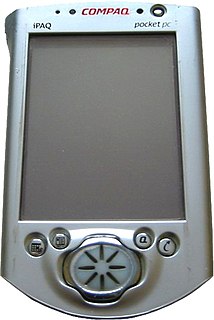
A Pocket PC is a class of personal digital assistant (PDA) that runs the Windows Mobile or Windows Embedded Compact operating system that has some of the abilities of modern desktop PCs. The name was introduced by Microsoft in 2000 as a rebranding of the Palm-size PC category. Some of these devices also had integrated phone and data capabilities, which were called Pocket PC Phone Edition or simply "Smartphone".

Palm was a line of personal digital assistants (PDAs) and mobile phones developed by California-based Palm, Inc., originally called Palm Computing, Inc. Palm devices are often remembered as "the first wildly popular handheld computers," responsible for ushering in the smartphone era.
The Zire Series was Palm, Inc's "consumer-grade" brand of Personal Digital Assistant.
A taskbar is an element of a graphical user interface which has various purposes. It typically shows which programs are currently running.

The Tungsten series was Palm, Inc.'s line of business-class Palm OS-based PDAs.

Windows Mobile is a discontinued family of mobile operating systems developed by Microsoft for smartphones and personal digital assistants.

The AlphaSmart was a brand of portable, battery powered, word-processing keyboards manufactured by NEO Direct, Inc.. Originally released in 1993, the first AlphaSmart models were intended for writing on-the-go and could be plugged into a computer to transfer saved written text. The units' portability and long battery life made them valuable to journalists, writers, and students. Later models expanded functionality by spell-checking, running applications, and accessing wireless printers.
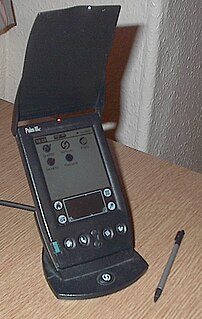
The Palm IIIc was the first colour PDA made by Palm, Inc., released in February 2000 for $449USD. It ran Palm OS 3.5, the first Palm OS version to have native colour support and supported paletted 8-bit colour modes. Using the Palm OS Upgrade Install CD, the Palm IIIc could be updated to Palm OS 4.1. The machine has a TFT LCD that is bright indoors. The Palm IIIc features the classic III-series connector, 8MB of RAM and a 20MHz DragonBall EZI CPU. The unit also has a lithium ion rechargeable battery and a slightly modified version of the original Palm III chassis.

The Pilot 1000 and Pilot 5000 were the first generations of PDAs produced by Palm Computing. It was introduced in March 1996.

Documents To Go is BlackBerry's cross-platform office suite for Palm OS, Windows Mobile, Maemo, BlackBerry OS, Symbian, Android, and iOS. Also, a larger-screen version would have been included with the Palm Foleo, but Palm, Inc. cancelled the device before its release. The desktop tool, which provides document synchronization between one's handheld device and one's computer, is available for both Microsoft Windows and Mac OS X. On 8 September 2010, it was announced that DataViz had sold the program along with other business assets to Research In Motion for $50 million.
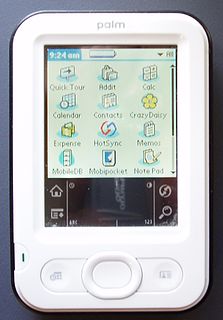
The Z22 was one of the first of Palm, Inc.'s handhelds to be released under the new "Palm" brand, and the first to be released without the "Zire" moniker. Released on October 12, 2005, it replaced the monochrome Zire 21, and was priced at $99 USD. The Palm Z22 came with Palm OS Garnet 5.4.9 preloaded and is not upgradable. It featured a 200 MHz Samsung S3C2410 ARM processor developed around the 32-bit ARM920T core that implements the ARMv4T architecture. The Z22 ran on a li-ion battery that had a life of about 8 hours depending on usage.
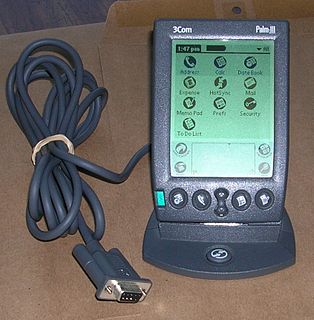
The Palm III is a personal digital assistant that was made by the Palm Computing division of 3Com. It went on sale in 1998 as a replacement for the PalmPilot handheld. It was the first Palm handheld to support infrared file transfer and a Flash ROM-capable operating system. At release, the Palm III was priced at US$400.
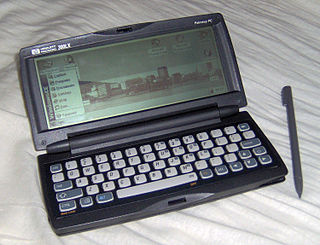
The HP 300LX was one of the first handheld PCs designed to run the Windows CE 1.0 operating system from Microsoft. Unlike other HPCs of the time, the resistive touch screen had an enhanced screen resolution of 640x240 with 4 shades of grey, rather than the standard 480x240 resolution of other devices, such as the Casio Cassiopeia A-10. The device also sported a full PC card slot, a serial link cable plug, and an infrared port.
Handspring, Inc. was an American electronics company founded in 1998 by the founders of Palm, Inc. after becoming dissatisfied with the company's direction under new owner 3Com. The company developed Palm OS–based Visor- and Treo-branded personal digital assistants. In 2003, the company merged with Palm, Inc.'s hardware division.

The HTC Evo 4G is a smartphone developed by HTC Corporation and marketed as Sprint's flagship Android smartphone, running on its WiMAX network. The smartphone was launched on June 4, 2010. It was the first 4G enabled smartphone released in the United States.

Pocket PC 2000 is the first member of the Windows Mobile family of mobile operating systems that was released on April 19, 2000, and was based on Windows CE 3.0. It is the successor to the operating system aboard Palm-size PCs. Backwards compatibility was retained with such Palm-size PC applications. Pocket PC 2000 was intended mainly for Pocket PC devices, however several Palm-size PC devices had the ability to be updated also. Further, several Pocket PC 2000 phones were released, however Microsoft's "Smartphone" hardware platform was not yet created. The only resolution supported by this release was 240 x 320 (QVGA). Removable storage card formats that were supported were CompactFlash and MultiMediaCard. At this time Pocket PC devices had not been standardized with a specific CPU architecture. As a result, Pocket PC 2000 was released on multiple CPU architectures; SH-3, MIPS, and ARM. Infrared (IR) File beaming capability was among the original hardware features.

GPD Win is a Windows-based palmtop computer equipped with a keyboard and gaming controls. It is an x86-based device which runs a full version of Windows 10 Home. The GPD Win was envisioned, primarily, with video game console emulation and PC gaming in mind. Furthermore, the GPD Win is capable of running any x86 Windows-based application that can run within the confines of the computer's technical specifications. First announced in October 2015, it was crowdfunded via Indiegogo and two other crowdfunding sites in Japan and China. The GPD Win was released in October 2016.

















